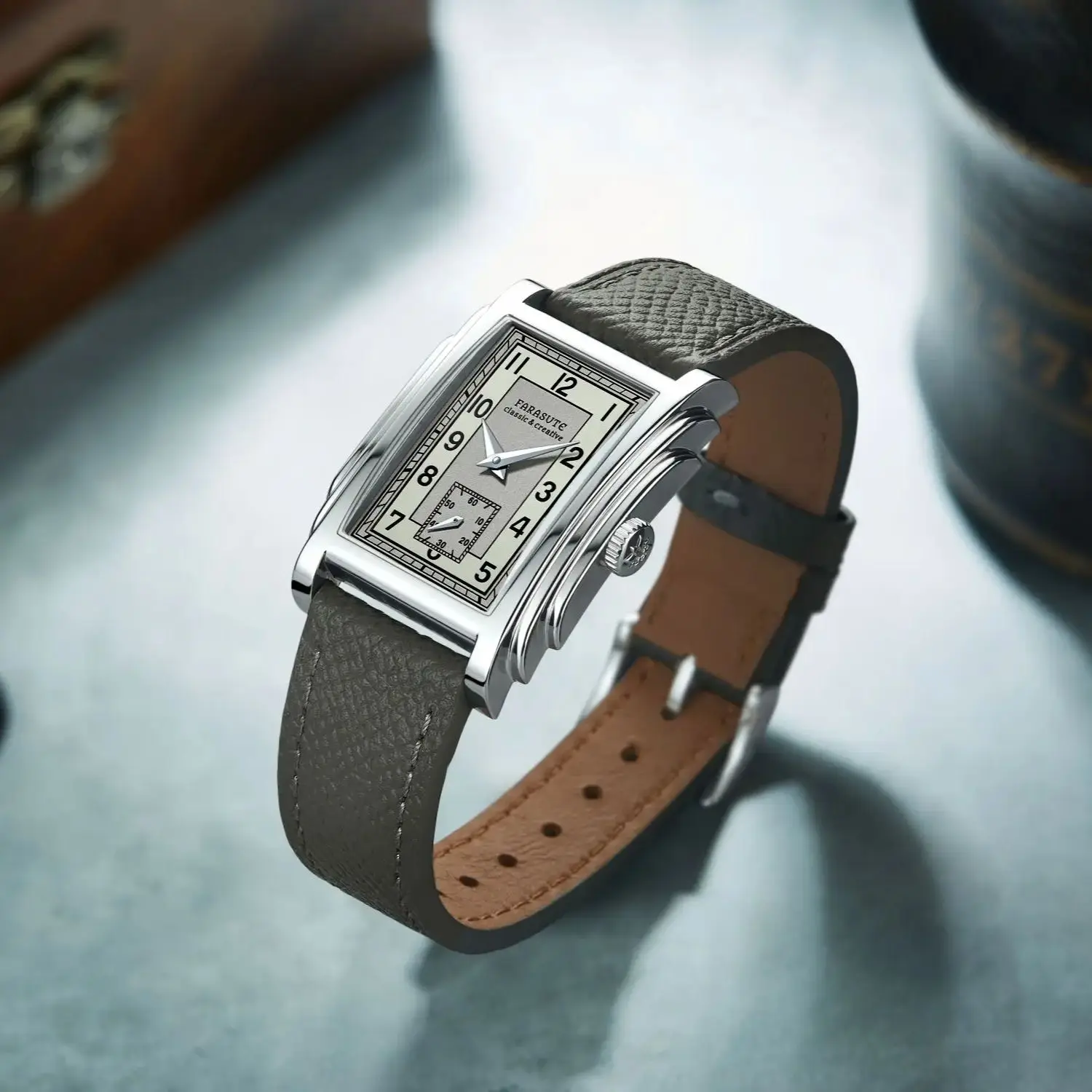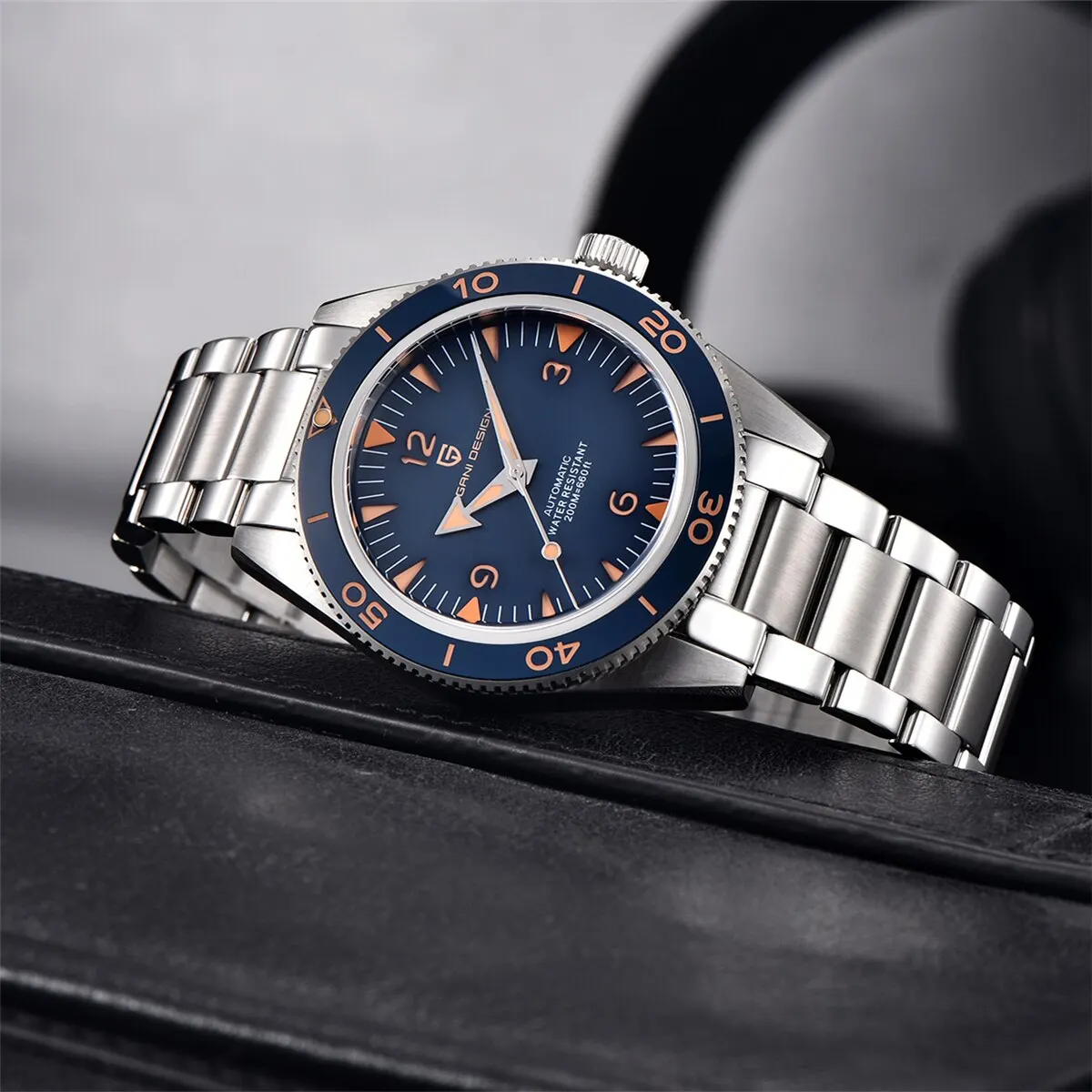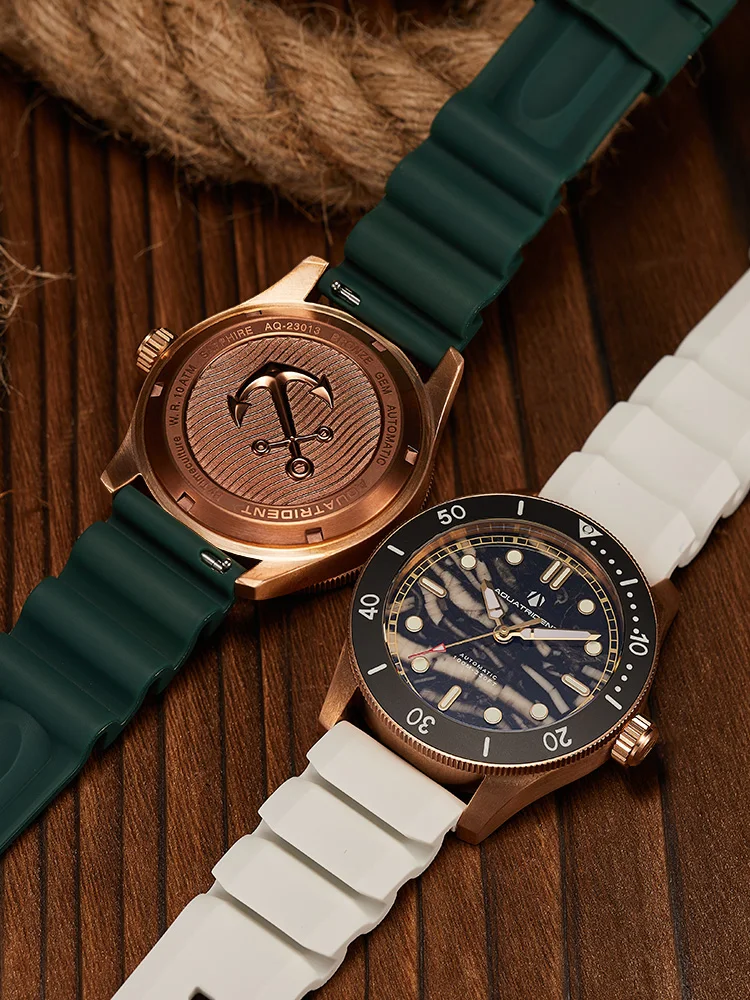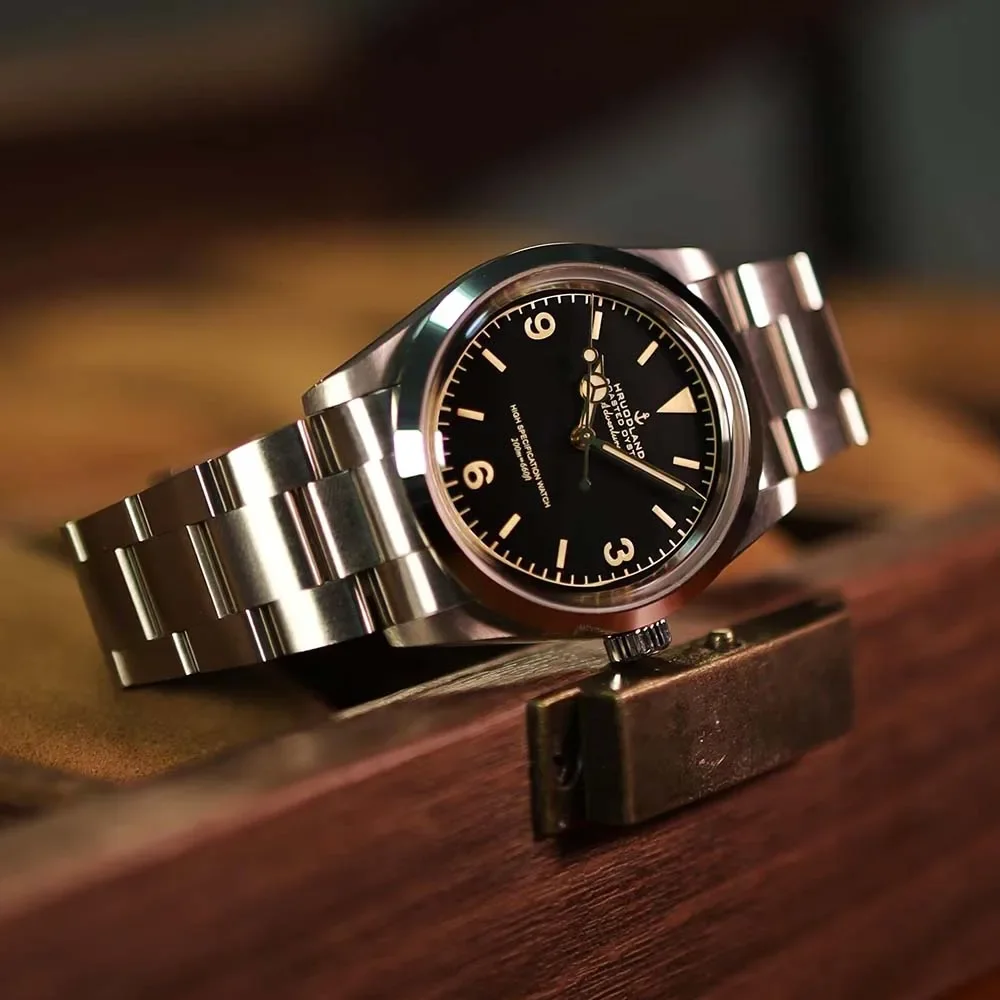The Art of Watch Case Thickness: Why It Matters
When it comes to timepieces, the thickness of a watch case is much more than just a number on a specification sheet. It’s a fundamental element that shapes both how a watch looks and how it feels on your wrist. Case thickness influences everything from your comfort throughout the day to how easily your watch pairs with different outfits.
Think of watch thickness as similar to the profile of a car—some people prefer the sleek lines of a sports car, while others appreciate the commanding presence of an SUV. Neither is inherently “better”—they simply serve different purposes and appeal to different tastes.
What makes this topic fascinating is that your perfect watch thickness depends on several personal factors:
- Your wrist size and shape
- Your typical daily activities
- Your style preferences
- The occasions where you’ll wear your timepiece
Understanding thin case design evolution can provide valuable context for appreciating modern watches and their various profiles. Today’s market offers incredible variety, from ultra-slim dress pieces that slide effortlessly under a shirt cuff to substantial dive watches built to withstand extreme conditions.
Throughout this guide, we’ll explore how different thicknesses affect the look and functionality of watches, helping you identify which profile might be your ideal match. Whether you’re drawn to the elegant restraint of thin automatic dress watches or something with more presence, understanding thickness will enhance your appreciation of fine timepieces.
Understanding Watch Case Measurements: What Numbers Mean
Before diving into the aesthetics and feel of different watch thicknesses, let’s establish what these measurements actually mean in the watch world. Case thickness is typically measured in millimeters, from the caseback (the part that touches your wrist) to the top of the crystal (the clear cover protecting the dial).
Here’s a breakdown of the standard thickness categories you’ll encounter:
| Category | Thickness Range | Typical Watch Types |
|---|---|---|
| Ultra-thin | Under 8mm | High-end dress watches, formal timepieces |
| Thin | 8mm-10mm | Dress watches, minimalist designs |
| Medium | 10mm-12mm | Versatile everyday watches |
| Thick | 12mm-15mm | Sports watches, chronographs |
| Very thick/chunky | 15mm+ | Dive watches, specialized tools |
It’s important to note that thickness doesn’t exist in isolation. How a watch “wears” on your wrist depends on the interplay between several dimensions:
- Case diameter (the width of the watch face)
- Lug-to-lug distance (the total length across the watch)
- Case profile (how the sides are shaped)
A 12mm watch with a 38mm diameter will appear and feel very different from a 12mm watch with a 44mm diameter. The proportions matter tremendously, which is why simply reading measurements doesn’t tell the complete story of how a watch will look and feel on your wrist.
Understanding the definitive watch case thickness comparison can help you navigate these measurements with greater confidence. As you explore different watches, you’ll develop a sense for which proportions work best for your wrist and style preferences.
The Elegance of Thin: Aesthetic Benefits of Slim Profiles
Thin watches have long been associated with elegance and refinement. A slim profile speaks of watchmaking excellence, as creating a functional timepiece in minimal space requires exceptional engineering.
From an aesthetic standpoint, thin watches offer several distinctive qualities:
- Understated sophistication: Thin watches whisper rather than shout, conveying confidence through restraint
- Timeless design language: Slim profiles often feature clean lines and minimal ornamentation that remains stylish across decades
- Visual lightness: The reduced vertical presence creates an airy, delicate appearance on the wrist
- Proportional harmony: Thin cases often feature balanced dial elements and refined detailing
The visual appeal of a thin watch largely comes from its ability to complement rather than dominate. When worn with formal attire, a slim timepiece continues the sleek lines of a tailored suit rather than interrupting them. This creates a harmonious overall appearance that many find appealing.

Historically, the finest dress watches have been designed with minimal thickness. This tradition stems partly from practical concerns—a watch that easily slides under a shirt cuff is more versatile—but also from aesthetic considerations. The benefits of slim watch cases include an inherent elegance that complements formal and business settings beautifully.
For those drawn to minimalist design principles, minimalist automatic watches with their clean dials and slim cases offer the perfect expression of “less is more” philosophy, proving that restraint often creates the most enduring aesthetic appeal.
Thin Watch Practicality: Beyond Aesthetics
While thin watches are celebrated for their beauty, they also offer significant practical advantages that make them excellent choices for everyday wear.
The most immediate benefit is comfort. A slim profile means less weight on your wrist, which can make a substantial difference during long days. The thin watch cases comfort analysis reveals how reduced thickness minimizes fatigue and pressure points, especially for those who spend hours at a desk or keyboard.
Other practical benefits include:
- Shirt cuff compatibility: Thin watches slide effortlessly under even tight shirt cuffs, eliminating the awkward bunching that thicker watches can cause
- Lower profile against impacts: With less height, thin watches are less likely to catch on doorframes, pockets, or other objects
- Discreet presence: In professional settings where subtlety is valued, a thin watch maintains elegance without drawing undue attention
- Reduced movement restriction: Activities requiring wrist flexibility become easier with a watch that doesn’t limit range of motion
Contrary to popular belief, many thin watches offer reasonable durability for everyday wear. While they may not be suitable for extreme sports, modern thin watches often provide adequate water resistance for daily activities and are built to withstand normal wear and tear.
For many professionals, the ability to wear a watch continuously from morning meetings through evening events makes a thin profile the most practical choice, regardless of its aesthetic appeal.
The Bold Statement: Aesthetic Benefits of Thick Cases
On the opposite end of the spectrum, thick watch cases offer a distinctive set of aesthetic qualities that appeal to many enthusiasts. A watch with substantial thickness creates an unmistakable presence on the wrist—a bold statement that commands attention.
The visual impact of thick cases stems from several key characteristics:
- Dimensional complexity: The increased height allows for layered dials, applied indices, and textural variety
- Visual weight: A thicker case creates a sense of substance and importance
- Architectural presence: The sides of a thick case become a canvas for interesting shapes, finishes, and details
- Masculine proportions: For many, the robust dimensions connect with traditional notions of masculinity and strength
- Technical appearance: Thickness often communicates mechanical complexity and capability
Thick watches tend to become focal points of an outfit rather than accessories. They make statements about the wearer’s personality and priorities, often suggesting an appreciation for engineering and functionality over conformity to formal dress codes.
The dramatic shadows cast by a thick case as light plays across its surfaces can create visual interest that slimmer watches simply can’t achieve. This dimensionality makes professional spec dive watches particularly captivating, as their robust cases often feature distinctive shapes and textures designed for both function and visual appeal.
While thin watches excel in understated elegance, thick watches shine when boldness and character are the goals. Their substantial presence can become a signature element of one’s personal style.
Thick Watch Functionality: Practical Advantages
Beyond their striking appearance, thick watch cases deliver practical benefits that make them the preferred choice for certain activities and lifestyles.
The additional case volume serves several functional purposes:
- Enhanced durability: More material typically means greater protection for the movement inside, particularly against shocks and impacts
- Superior water resistance: The extra space accommodates thicker gaskets and reinforced casebacks, allowing for higher water resistance ratings
- Movement accommodation: Complex mechanisms like chronographs, GMT functions, or perpetual calendars often require additional space
- Improved legibility: Thicker cases can house deeper dials with larger hour markers containing more luminous material
- Better power reserves: Room for larger mainsprings enables longer periods between winding
These practical advantages make thick watches natural choices for active pursuits. When diving, hiking, or engaging in sports, the robust construction provides peace of mind that your timepiece can handle the conditions.

The materials used in tough watch cases further enhance these practical benefits. From hardened stainless steel to titanium and ceramic, the materials that compose thicker cases often provide additional scratch resistance and structural integrity.
For those who prioritize functionality and durability, the increased thickness represents a worthwhile trade-off, delivering real-world benefits that align with active lifestyles and demanding environments.
Finding Your Fit: Matching Case Thickness to Wrist Size
Finding harmony between your wrist size and your watch’s thickness is essential for both comfort and aesthetics. The goal is proportion—a watch that complements rather than overwhelms or disappears on your wrist.
To determine your ideal range, start by measuring your wrist circumference:
- Small wrists: Under 6.5 inches (16.5 cm)
- Medium wrists: 6.5-7.25 inches (16.5-18.5 cm)
- Large wrists: Over 7.25 inches (18.5 cm)
As a general guideline, consider these thickness proportions:
| Wrist Size | Recommended Thickness Range | Notes |
|---|---|---|
| Small | 6mm-11mm | Favor thinner profiles to maintain proportion |
| Medium | 8mm-13mm | Most versatile range, can wear various styles |
| Large | 10mm-15mm+ | Can comfortably support thicker watches |
Remember that wrist shape matters as much as size. A flat wrist can typically support a slightly thicker watch than a round wrist of the same circumference, as the watch sits more flush against a flat surface.
The lug-to-lug distance (the vertical length of the watch including the parts that connect to the strap) is also crucial. If the lugs extend beyond your wrist edges, the watch will wear uncomfortably regardless of its thickness.
Exploring various options in the automatic watches collection can help you understand how different thicknesses look and feel on your specific wrist. Personal experimentation remains the best way to determine your ideal range.
Design Elements That Affect Perceived Thickness
Interestingly, the actual measured thickness of a watch doesn’t always match how thick it appears on the wrist. Several design elements can visually increase or decrease a watch’s perceived bulk:
- Case profile: Watches with straight sides appear thicker than those with curved or sloping profiles that taper toward the edges
- Bezel design: A tall, vertical bezel emphasizes thickness, while an angled or rounded bezel can visually reduce height
- Crystal shape: Flat crystals create a sharper visual cutoff, while domed crystals blend the transition from case to crystal
- Caseback contour: A deeply curved caseback that nestles into the wrist makes a watch wear thinner than its specifications suggest
- Dial depth: A dial with multiple levels and deep indices creates the impression of greater thickness
- Case color and finish: Darker colors and matte finishes tend to make watches appear slimmer than polished or light-colored cases
These visual tricks explain why two watches with identical thickness measurements can look and feel dramatically different when worn. Watchmakers often use these design elements strategically to manage the visual weight of their timepieces.
When evaluating a watch, consider how these elements work together rather than focusing solely on the thickness specification. A 13mm watch with a curved profile and domed crystal might actually appear slimmer than an 11mm watch with straight sides and a flat crystal.
Movement Matters: How Watch Mechanisms Affect Case Height
The mechanical heart inside a watch significantly influences its external dimensions. Different movement types require varying amounts of space, directly affecting case thickness:
- Quartz movements are typically the thinnest option, often allowing for cases under 7mm
- Hand-wound mechanical movements eliminate the automatic rotor, permitting relatively thin profiles (often 8-10mm)
- Automatic mechanical movements need space for the oscillating rotor that winds the mainspring, adding about 1.5-2mm
- Complicated movements like chronographs or perpetual calendars stack additional mechanism layers, further increasing necessary thickness
The quality and engineering sophistication of the movement also play important roles. The engineering behind slim watch movements reveals the incredible precision required to create ultra-thin calibers that remain reliable.
High-end manufacturers often invest significantly in developing thinner movements, using techniques like:
- Merging component functions to reduce parts
- Creating off-center micro-rotors for automatics
- Utilizing peripheral rotors that circle the movement
- Developing flatter mainsprings and balance wheels
These innovations allow for mechanically complex watches that maintain reasonably slim profiles, though they typically command premium prices due to the engineering challenges involved.
Understanding the relationship between movement and case thickness helps explain why certain watch types tend to have specific thickness ranges. It’s not merely an aesthetic choice but a functional requirement of what lies inside.
Occasion and Style: When to Choose Thin vs. Thick
Traditional watch etiquette suggests different thickness profiles for different situations, though contemporary style has become more flexible. Here’s a general guide to matching watch thickness with occasions:
| Setting | Recommended Thickness | Watch Style |
|---|---|---|
| Formal events (black tie) | Under 8mm | Ultra-thin dress watch |
| Business formal | 8-10mm | Dress or minimalist watch |
| Business casual | 9-12mm | Versatile dress or sports watch |
| Casual everyday | 10-14mm | Sports watch or robust everyday piece |
| Active/outdoor | 12mm+ | Tool watch, dive watch, field watch |
The traditional rule states that the more formal the occasion, the thinner the watch should be. This stems from both practical considerations (fitting under tight formal shirt cuffs) and aesthetic ones (maintaining the clean lines of formal attire).

The concept of navigating elegance ultra-thin formal watches continues this tradition, though modern fashion has relaxed many of these conventions. Today, personal style often takes precedence over strict rules.
That said, certain pairings remain particularly harmonious: the refined elegance of a thin watch with business attire, or the robust character of a thick sport watch with casual weekend wear. Understanding these traditional guidelines gives you the foundation to either follow them or thoughtfully break them according to your personal style.
Beyond Thickness: Other Factors That Impact Wearability
While thickness significantly influences how a watch feels, several other dimensions work in concert to determine overall wearability:
- Case diameter: The width of the watch face (typically 36-45mm) should be proportionate to your wrist width
- Lug-to-lug distance: This total length (often 44-52mm) should not exceed your wrist width
- Lug design: How the case connects to the strap affects how the watch conforms to your wrist
- Weight distribution: A well-balanced watch feels more comfortable than one that’s top or side-heavy
- Strap or bracelet: The material, thickness, and flexibility of the attachment impacts overall comfort
- Crown design: Recessed or protected crowns prevent digging into the back of your hand
The interplay between these elements creates the complete wearing experience. A thinner watch with uncomfortable lugs might feel worse than a thicker watch with ergonomic case design.
When evaluating watches, consider how these elements work together. The most comfortable watches typically feature thoughtful design across all dimensions, creating harmony between the timepiece and your wrist’s unique characteristics.
Classic Automatic Dress Watches, Day Date Automatic Watches, Perpetual Calendar Automatic Watches
Price range: $540.60 through $574.60 Select options This product has multiple variants. The options may be chosen on the product pageAutomatic Chronograph Watches, Chronograph Pilot Watches
Price range: $233.36 through $237.58 Select options This product has multiple variants. The options may be chosen on the product pageClassic Automatic Dress Watches, GMT Automatic Watches, GMT Pilot Watches
Price range: $1,240.86 through $1,463.33 Select options This product has multiple variants. The options may be chosen on the product pageAutomatic Chronograph Watches, Classic Style Dive Watches
$3,053.06 Select options This product has multiple variants. The options may be chosen on the product pageAutomatic Skeleton Watches, Open Heart Automatic Watches
$98.36 Select options This product has multiple variants. The options may be chosen on the product pageBronze Automatic Watches, Military Inspired Automatic Watches, Professional Spec Dive Watches
Price range: $1,442.21 through $1,442.82 Select options This product has multiple variants. The options may be chosen on the product page
For daily wear, this holistic approach to watch dimensions becomes particularly important, as even minor discomfort can become significant when experienced throughout the day.
Finding Balance: The “Goldilocks” Watch Thickness
For many watch enthusiasts, the sweet spot lies somewhere in the middle—watches that are neither too thin nor too thick, but “just right.” This middle ground, typically between 9-12mm, offers several advantages:
- Sufficient durability for everyday activities
- Reasonable water resistance (often 50-100m)
- Comfortable all-day wearing experience
- Versatility across multiple settings and outfits
- Visual presence without overwhelming the wrist
These moderately proportioned watches often become the most versatile pieces in a collection. They can transition from office to evening wear without feeling out of place, and they typically strike a pleasant balance between refined aesthetics and practical functionality.
Finding your personal “Goldilocks zone” might require trying several different thicknesses. Pay attention to which watches you reach for most often—this natural preference reveals valuable information about your ideal thickness range.
Many enthusiasts eventually discover that having watches of varying thicknesses serves different needs in their lives. A collection might include an ultra-thin dress piece for formal occasions, a mid-sized everyday watch, and a robust sport watch for weekends and adventures.
Evolution of Case Thickness: Trends and Innovations
Watch case thickness has evolved considerably throughout horological history, reflecting both technological capabilities and changing fashion preferences.
Early pocket watches were necessarily thick due to their primitive movements. As engineering advanced, pocket watches became progressively thinner, with the finest examples representing extraordinary technical achievements.
When wristwatches emerged in the early 20th century, thinness became a significant goal. Mid-century dress watches were typically quite slim, reflecting the elegant aesthetics of the era.
The 1970s saw the rise of sports watches with increased water resistance, requiring thicker cases. By the 2000s, oversized watches had become fashionable, with some reaching extreme proportions exceeding 15mm in thickness.
Recent years have witnessed a return to more moderate dimensions, with modern trends thin watch profiles showing renewed appreciation for classic proportions. Vintage-inspired designs have fueled interest in thinner cases, while innovations in materials and manufacturing have enabled stronger yet slimmer designs.
Today’s market features remarkable diversity. Ultra-thin record-breakers measuring under 4mm coexist with 17mm+ dive watches capable of withstanding extreme depths. This variety gives today’s enthusiasts unprecedented choices across the thickness spectrum.
Try Before You Buy: Practical Tips for Evaluating Thickness
Finding your perfect watch thickness requires hands-on experience. Here are practical strategies for assessing whether a watch’s thickness works for you:
- Wear test duration: Spend at least 15 minutes with a watch on your wrist—initial impressions can be misleading
- Test typical movements: Simulate typing, driving, and other common activities to check for interference or discomfort
- Try with relevant clothing: If possible, test the watch with clothing similar to what you’ll typically wear with it
- Check different positions: Note how the watch feels both when your arm is hanging naturally and when bent at various angles
- Consider seasonal changes: Remember that your wrist size fluctuates slightly with temperature and humidity
For online shoppers without in-person trial opportunities:
- Look for images of the watch worn on wrists of different sizes
- Check the complete dimensions (diameter, lug-to-lug, and thickness) against watches you already own
- Read owner reviews specifically mentioning comfort and wearability
- Consider the watch’s weight, which often correlates with perceived thickness
- Look for profile views that show the case shape from the side
Taking time with this evaluation process helps prevent purchasing watches that look appealing in photos but feel uncomfortable in daily wear.
Is Thinner Always Better? Challenging Common Assumptions
Within watch collecting circles, there’s sometimes an implicit assumption that thinner watches represent superior craftsmanship and refinement. While creating ultra-thin movements does require exceptional technical skill, thinness itself isn’t inherently better—it’s simply different.
Many watch enthusiasts actually prefer the substantial feel of thicker watches. They appreciate:
- The reassuring weight on the wrist
- The impressive visual presence
- The robust, tool-like character
- The technical capabilities enabled by additional space
Cultural preferences also influence thickness perception. European watchmaking traditions often emphasize slimness, while some markets show greater appreciation for substantial timepieces that make bolder statements.
The most important realization is that thickness should serve the watch’s purpose. A dive watch needs certain dimensions to function properly, while a formal dress watch fulfills different requirements. Judging all watches by the same thickness standard misses the point of their specialized designs.
Rather than seeking the thinnest possible watch, focus on finding the thickness that best serves your needs, complements your style, and feels comfortable on your wrist.
Frequently Asked Questions
Is a 12mm watch considered thick?
In the context of modern watches, 12mm represents a middle ground. For dress watches, 12mm would be considered somewhat thick, while for sports watches, this would be moderate or even relatively slim. The perception depends greatly on the watch’s overall proportions and intended purpose.
Can thick watches be worn with formal attire?
While traditionally discouraged, contemporary style allows more flexibility. If choosing a thicker watch for formal wear, look for refined design elements, a smaller diameter, and possibly precious metals. The watch will be noticed, so ensure it complements rather than clashes with your formal look.
Do thin watches last as long as thick ones?
With proper care, a well-made thin watch can be just as durable over time. While thicker watches may better withstand impacts, quality thin watches are engineered to protect their movements appropriately. Regular maintenance matters more for longevity than case thickness.
Are thinner watches more expensive to produce?
Often yes. Ultra-thin movements require exceptional engineering precision, specialized components, and more intensive labor. However, many factors influence price beyond thickness, including materials, finishing quality, brand prestige, and movement complexity.
How much does thickness affect comfort for daily wear?
Thickness significantly impacts comfort, but in ways that vary by individual. Some find thicker watches uncomfortable under sleeves or top-heavy, while others dislike the insubstantial feel of ultra-thin watches. Wrist size, daily activities, and personal preference determine your ideal comfort range.
Your Perfect Profile: Embracing Personal Preference
After exploring the nuances of watch case thickness, one truth becomes clear: there is no universally “correct” thickness—only what works best for you. Your perfect profile depends on a unique combination of:
- Your physical characteristics
- Your lifestyle and activities
- Your aesthetic preferences
- Your collection goals
Some enthusiasts develop strong preferences for either thin or thick watches, while others appreciate both for different contexts. Many collectors find that their preferences evolve over time, often beginning with larger watches before gravitating toward more moderate dimensions as their appreciation deepens.
The most satisfying approach is to experience various thicknesses firsthand, paying attention to which watches bring you the most enjoyment. Trust your personal comfort and aesthetic judgment over conventional wisdom or trends.
Remember that the best watch is ultimately the one you love wearing—regardless of whether it’s razor-thin or robustly thick. The perfect profile is the one that feels right on your wrist and brings you pleasure each time you check the time.







